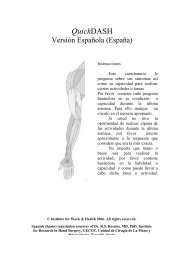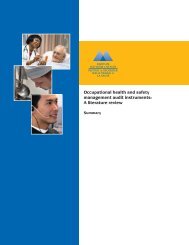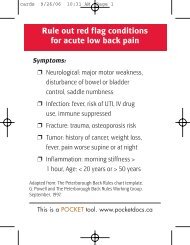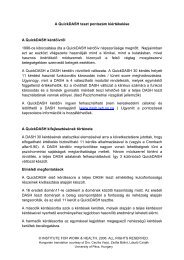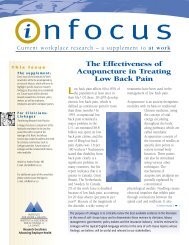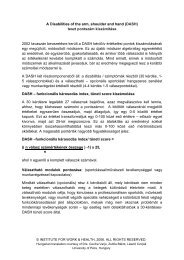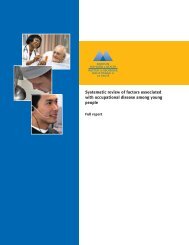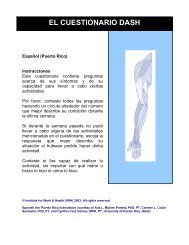A systematic review of injury/illness prevention and loss control ...
A systematic review of injury/illness prevention and loss control ...
A systematic review of injury/illness prevention and loss control ...
- No tags were found...
Create successful ePaper yourself
Turn your PDF publications into a flip-book with our unique Google optimized e-Paper software.
Table 4: Best evidence synthesis guidelinesLevel <strong>of</strong> Minimum Minimum Consistencyevidence quality quantityStrong High(>85%)>=3studiesAll high quality studies convergeon the same findings.Moderate Medium(50-84%)>=2studiesMajority <strong>of</strong> medium qualitystudies converge on the samefindings.Mixed Medium(50-84%)>=2studiesMedium <strong>and</strong> better qualitystudies have inconsistentfindings.Partial Low >=2 Majority <strong>of</strong> low quality studies(0-49%) studies converge on the same findings.Insufficient The above criteria are not met.In order to apply the best evidence guidelines uniformly some decisions wereused in the <strong>systematic</strong> <strong>review</strong>:• If a <strong>review</strong>ed study did not have the primary outcome as an <strong>injury</strong>,<strong>illness</strong> or workers' compensation claim/cost but data was reported inany <strong>of</strong> these areas, the evidence was included in the synthesis.• Values were abstracted from figures (e.g. graphs, tables) wherespecific data was not reported.• When multiple findings were reported, we examined whether multiplecomparisons were conducted appropriately. If not, the results were<strong>review</strong>ed by the team <strong>and</strong> consensus was reached.• Pain <strong>and</strong> discomfort were classified as injuries, <strong>and</strong> comfort <strong>and</strong>satisfaction were not.• Medical interventions were not considered an IPC.• Some interventions were considered “programs” (e.g. return-to-work,disability management) <strong>and</strong> the reported effects were considered as anindication <strong>of</strong> effectiveness <strong>of</strong> the program rather than the effectiveness<strong>of</strong> an individual program component.A <strong>systematic</strong> <strong>review</strong> <strong>of</strong> <strong>injury</strong>/<strong>illness</strong> <strong>prevention</strong> <strong>and</strong> <strong>loss</strong> <strong>control</strong>programs (IPCs)19



